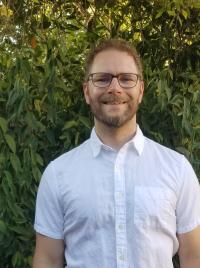Our Pilot Projects Program is one of the main ways we fund environmental health research.
GloNad: A Novel Assay for Reproductive Toxicants Using Zebrafish

- Principal Investigator: Sean Burgess (smburgess@ucdavis.edu), Molecular and Cellular Biology
- Principal Investigator: Bruce Draper (bwdraper@ucdavis.edu), Molecular and Cellular Biology
The problem: Many residents of California’s Central Valley live and work near agricultural production sites, which puts them at higher risk of exposure to pesticides than the general population. Pesticide exposure can lead to both acute and long-term health issues, including harm to the reproductive system that may show up as reduced fertility or an increased risk of birth defects. There are 90 pesticides known to the State of California to cause birth defects or reproductive harm. However, current methods for testing pesticide toxicity, which involve the use of mice, are expensive, slow, and limited in their ability to detect impacts at the earliest stages of human development.
The project: Zebrafish are freshwater fish native to South Asia that are popular in home aquariums. They have also emerged as a promising species to help scientists study early human development. Their bodies are nearly transparent and the sex of zebrafish is determined in part by environmental exposure. Animals exposed to chemicals that disrupt the process of oogenesis will develop solely as males. Drs. Burgess and Draper have developed a way to quickly determine the male-to-female ratio of live zebrafish by assaying the expression of fluorescent sex-specific proteins that can be seen and analyzed by a camera and computer.
Because zebrafish are easy to care for and reproduce quickly, this new model will enable them to test potential toxins far more quickly than traditional methods and with higher sensitivity. This means reproductive effects that impact a small percentage of an exposed population – too small to detect with traditional methods—could be detected with zebrafish. Drs. Burgess and Draper will test and refine the zebrafish model they have developed using a set of pesticides of concern to EHSC’s community partners in the Central Valley.
Cortical Tri-Culture Platform for Environmental Neurotoxin Screening

- Principal Investigator: Erkin Şeker (eseker@ucdavis.edu), Electrical and Computer Engineering
- Community Partner: Californians for Pesticide Reform and California Healthy Nail Salon Collaborative
The problem: Environmental toxins, including particulates, heavy metals, and pesticides, play an important role in neurodegenerative and neurodevelopmental disorders, and often associated neuroinflammation. Previous studies have suggested that specific cell types in the central nervous system (CNS) are involved in these neurological conditions, but how toxins may interact with these cells to cause neuroinflammation and alter neural function remains poorly understood. Conventional methods of studying the influence of toxins on the CNS are either costly and slow (“in vivo” / animal models) or limited by their inability to look at multiple critical cell types at the same time (conventional “in vitro” / cell models).
The project: This project involves the development of an innovative model that integrates multiple neural cell types (including microglia – a resident immune cell) at the same time, which better represents the actual complexity of the CNS than single-cell models. In addition, it is more scalable than animal models – meaning more substances can be rapidly tested in parallel. Dr. Seker will collaborate with two community-based organizations, Californians for Pesticide Reform and the California Healthy Nail Salon Collaborative, to select substances that are of concern to their stakeholders.
Effects of Climate Change and Dietary Quality on Maternal-Infant Health Outcomes in the GROWell Trial

- Principal Investigator: Leigh Ann Simmons (lasimm@ucdavis.edu), Human Ecology
- Co-Principal Investigator: Clare Cannon (cebcannon@ucdavis.edu), Human Ecology
The problem: There is a significant gap in knowledge in how climate change affects the health of pregnant people and their offspring. Extreme heat, increased air pollution, and other stressors caused by climate change can impact both physical and mental health and contribute to widening existing social inequities (Seeni et al., 2018) associated with race and ethnicity, income, and disability (Kuras et al., 2015). Although considered vulnerable populations, pregnant people and their newborn offspring have often been left out of research into health effects related to climate change (Bekkar et al., 2020; Kuehn & McCormick,2017).
The project: This project will use data from an existing study (Goals for Reaching Optimal Wellness – GROWell), which assesses the impact of a text-based educational and behavior change intervention on diet quality and weight gain during pregnancy and birth outcomes and weight loss after pregnancy. Dr. Simmons will integrate exposure to environmental stressors associated with climate change (e.g., extreme heat exposure, air pollution) into the GROWell data to assess the impact of these exposures on the health outcomes of pregnant people and their offspring.
Mobile Source Monitoring Support for Environmental Justice Communities

- Principal Investigator: Nicholas Spada (njspada@ucdavis.edu), Air Quality Research Center
- Community Partner: Citizen Air Monitoring Network and Sustainable Solano
The problem: Mobile sources, such as locomotives, marine vessels, and highway diesel trucks, frequently cross jurisdictional boundaries with varying environmental control requirements, making it difficult to accurately estimate their contributions to local air pollution. Current methods of monitoring pollution cannot differentiate between pollution from these mobile sources or pollution that was already in the air. Higher quality pollutant measurements can provide more robust health impact assessments and better inform regulatory and legislative action for frontline communities.
The project: Our project is a novel air monitoring, epidemiological observational study, and community-driven citizen science pilot that translates air pollution monitoring into health impacts, community action, and policy. With advancements in real-time sensor technologies and miniaturized computer systems, in situ measurements may answer several questions, including: (1) Does the transport, storage, and handling of materials contribute to increases in particulate matter air pollution (PM2.5)? and, if so, (2) What are the associated health and environmental justice effects?
Contact
If you'd like more information about a particular project, please contact Ruth Williams (ruwilliams@ucdavis.edu) for details.